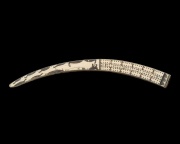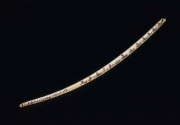Walrus tusk
Description
Long, upper canine teeth of the Atlantic walrus (Odobenus rosmarus), and the Pacific walrus (Odobenus obesus). Male walruses use these elongated teeth for fighting and as hooks for ice-climbing. The composition of the walrus teeth is similar to ivory and they have been used since the Middle Ages for carved art objects in North America, Europe and Asia. The tusks can reach lengths of 1-2 feet and weight up to 15 pounds. They have a hard, yellowish-white enamel covering that is removed prior to carving. Walrus tusks are primarily composed of dentin, a hard calcareous material composed of calcium hydroxyapatite with small amounts of calcium carbonate, calcium fluoride, and magnesium phosphate. They are solid, without any noticeable grain. A thick core of crystalline secondary dentin aids in the identification of walrus tusk objects. Beach ivory is the Eskimo name for fossilized walrus tusks that are sometimes washed up on Arctic beaches (Untracht 1985). These can be a mottled brown with violet regions.
Synonyms and Related Terms
beach ivory; walrus ivory; morse ivory; whale horse ivory; Walrosselfenbein (Deut.)
Other Properties
UV fluorescence is buff and white with some purple.
| Density | 1.90-2.00 |
|---|
Additional Information
° J.Thornton,"The Structure of Ivory and Ivory Substitutes", AIC Preprints, Philadelphia, 1981, p.173-181. ° O. Untracht, Jewelry Concepts and Technology, Doubleday & Co., Inc., New York, 1985.
Additional Images
Authority
- Hermann Kuhn, Conservation and Restoration of Works of Art and Antiquities, Butterworths, London, 1986
- Oppi Untracht, Jewelry Concepts and Technology, Doubleday & Co., Inc., New York City, 1985
- The Dictionary of Art, Grove's Dictionaries Inc., New York, 1996 Comment: F.Minney 'Ivory'
- Benjamin Burack, Ivory and Its Uses, Charles E. Tuttle and Co., Vermont, 1984



